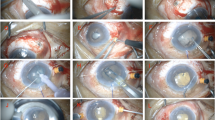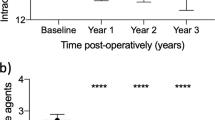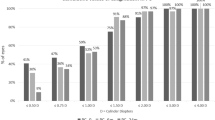Abstract
Purpose
To compare outcomes of phaco-canaloplasty (PC) and phaco-non-penetrating deep sclerectomy (PDS) with a viscoelastic compound.
Methods
This study included 29 eyes after PC and 30 after PDS. Indications were uncontrolled primary open-angle glaucoma (POAG) and a cataract. Corrected distance visual acuity (CDVA), intraocular pressure (IOP), and number of medications were evaluated. Follow-up examinations were performed on days 1 and 7, and after 1, 3, 6, and 12 months. Complete and qualified success was an IOP ≤ 18 mmHg.
Results
At the 12-month follow-up, mean IOP decreased in the PC group from 19.0 ±6.9 mmHg to 12.6 ±2.7 mmHg, and in the PDS group, from 19.1 ±5.8 mmHg to 14.3 ±3.5 mmHg (P < 0.05). Both groups preoperatively and at 12 months showed no significant differences in IOP (P > 0.05). There was no statistically significant difference between the number of medications used (P > 0.05). Complete and qualified success rates for both groups were 79.0 % and 76.9 % (P = 0.701). The most frequent postoperative PC complication was hyphema (58.0 %); for PDS, bleb fibrosis was most frequent (26.7 %). No PC patients required postoperative management. PDS patients required postoperative interventions 58.7 % of the time, including a 5-fluorouracil (5-FU) injection (58.7 %), suture lysis (48.3 %), and needling (27.6 %).
Conclusions
Both PC and PDS lead to an effective decrease in IOP on a short-term follow-up basis and demonstrate similar efficacy and safety profiles. PDS patients required additional procedures including 5-FU injections, suture lysis, or needling. PC patients required no additional procedures.



Similar content being viewed by others
References
Fyodorov SN, Kozlov VI, Timoshkina NT (1989) Non-penetrating deep sclerectomy in open angle glaucoma. Eye Microsurg 1:52–55
Stegman RC (1995) Viscocanalostomy: a new surgical technique for open angle glaucoma. An Inst Barraquer 25:225–232
Lewis RA, von Wolff K, Tetz M, Korber N, Kearney JR, Shingleton B, Samuelson TW (2007) Canaloplasty: circumferential viscodilation and tensioning of Schlemm’s canal using a flexible microcatheter for the treatment of open-angle glaucoma in adults: interim clinical study analysis. J Cataract Refract Surg 33:1217–1226
Bull H, von Wolff K, Körber N, Tetz M (2011) Three-year canaloplasty outcomes for the treatment of open-angle glaucoma: European study results. Graefes Arch Clin Exp Ophthalmol 249:1537–1545
Shingleton B, Tetz M, Korber N (2008) Circumferential viscodilation and tensioning of Schlemm canal (canaloplasty) with temporal clear corneal phacoemulsification cataract surgery for open-angle glaucoma and visually significant cataract. One-year results. J Cataract Refract Surg 34:433–440
Peckar CO, Körber N (2008) Canaloplasty for open angle glaucoma: a three years critical evaluation and comparison with viscocanalostomy. Spektrum Augenheilkd 22:240–246
Tetz M, Koerber N, Shingleton BJ, von Wolff K, Bull H, Samuelson TW, Lewis RA (2013) Phacoemulsification and intraocular lens implantation before, during, or after canaloplasty in eyes with open-angle glaucoma: 3-year results. J Glaucoma [epub ahead of print].
Grieshaber MC, Pienaar A, Olivier J, Stegmann R (2010) Canaloplasty for primary open-angle glaucoma: long-term outcome. Br J Ophthalmol 94:1478–1482
Grieshaber MC, Fraenkl S, Schoetzau A, Flammer J, Orgül S (2011) Circumrential viscocanalostomy and suture canal distension (canaloplasty) for whites with open-angle glaucoma. J Glaucoma 20:298–2302
Mendrinos E, Mermoud A, Shaarawy T (2008) Nonpenetrating glaucoma surgery. Surv Ophthalmol 53:592–630
Johnson DH, Johnson M (2001) How does nonpenetrating glaucoma surgery work? Aqueous outflow resistance and glaucoma surgery. J Glaucoma 10:55–67
Matlach J, Freiberg FJ, Leippi S, Grehn F, Klink T (2013) Comparison of phacotrabeculectomy versus phacocanaloplasty in the treatment of patients with concomitant cataract and glaucoma. BMC Ophthalmol 29:13. doi:10.1186/1471-2415-13-1
Brüggemann A, Despouy JT, Wegent A, Müller M (2013) Comparison of canaloplasty versus trabeculectomy with Mitomycin C in a single-surgeon series. J Glaucoma 22:577–583
Schoenberg ED, Chaudhry AL, Chod R, Zurakowski D, Ayyala RS (2013) Comparison of surgical outcomes between phacocanaloplasty and phacotrabeculectomy at 12 months’ follow-up: a longitudinal cohort study. J Glaucoma [epub ahead of print]
Koerber NJ (2012) Canaloplasty in one eye compared with viscocanalostomy in the contralateral eye in patients with bilateral open-angle glaucoma. J Glaucoma 21:129–134
Schulzer M (1994) Errors in the diagnosis of visual field progression in normal-tension glaucoma. The normal-tension glaucoma study group. Ophthalmology 101:1589–94
Leske MC, Heijl A, Hyman L, Bengtsson B (1999) The early manifest glaucoma trial: design and baseline data. Ophthalmology 106:2144–53
Bellucci R, Morselli S (2005) Reverse flap dissection for glaucoma surgery. Ophthalmic Surg Lasers Imaging 36:79–81
Roy S, Thi HD, Feusier M, Mermoud A (2012) Crosslinked sodium hyaluronate implant in deep sclerectomy for the surgical treatment of glaucoma. Eur J Ophthalmol 22:70–6
Shaarawy T, Flammer J, Smits G, Mermoud A (2004) Low first postoperative day intraocular pressure as a positive prognostic indicator in deep sclerectomy. Br J Ophthalmol 88:658–661
Karlen ME, Sanchez E, Schnyder CC, Sickenberg M, Mermoud A (1999) Deep sclerectomy with collagen implant: medium term results. Br J Ophthalmol 83:6–11
Tam DY, Barnebey HS, Ahmed II (2013) Nd:Yag laser goniopuncture: indications and procedure. J Glaucoma 22:620–625
Alp MN, Yarangumeli A, Koz OG (2010) Kural G (2010) Nd:YAG laser goniopuncture in viscocanalostomy: penetration in non-penetrating glaucoma surgery. Int Ophthalmol 30:245–252
Brüggemann A, Müller M (2012) Trabeculectomy versus canaloplasty-utility and cost-effectiveness analysis. Klin Monatsbl Augenheilkd 229:1118–1123
Gianoli F, Schnyder CC, Bovey E, Mermoud A (1999) Combined surgery for cataract and glaucoma: phacoemulsification and deep sclerectomy compared with phacoemulsification and trabeculectomy. J Cataract Refract Surg 25:340–346
Shaarawy T, Mansouri K, Schnyder C, Ravinet E, Achache F, Mermoud A (2004) Long-term results of deep sclerectomy with collagen implant. J Cataract Refract Surg 30:1225–1231
Gesser C, Matthaei M, Meyer-Rüsenberg B, Richard G, Klemm M (2012) Effect of combined cataract surgery and canaloplasty on postoperative intraocular pressure (IOP). Ophthalmologe 109:770–776
Battista SA, Lu Z, Hofmann S, Freddo T, Overby DR, Gong H (2008) Reduction of the available area for aqueous humor outflow and increase in meshwork herniations into collector channels following acute IOP elevation in bovine eyes. Invest Ophthalmol Vis Sci 49:5346–5352
Klink T, Panidou E, Kanzow-Terai B, Klink J, Schlunck G, Grehn FJ (2012) Are there filtering blebs after canaloplasty? J Glaucoma 21:89–94
Mermoud A, Schnyder CC, Sickenberg M, Chiou AG, Hédiguer SE, Faggioni R (1999) Comparison of deep sclerectomy with collagen implant and trabeculectomy in open-angle glaucoma. J Cataract Refract Surg 25:323–331
Broadway DC, Chang LP (2001) Trabeculectomy, risk factors for failure and the preoperative state of the conjunctiva. J Glaucoma 10:237–249
Grieshaber MC, Pienaar A, Olivier J, Stegmann R (2013) Clinical evaluation of the aqueous outflow system in primary open-angle glaucoma for canaloplasty. Invest Ophthalmol Vis Sci 51:1498–504
Grieshaber MC, Schoetzau A, Flammer J, Orgül S (2013) Postoperative microhyphema as a positive prognostic indicator in canaloplasty. Acta Ophthalmol 91:151–156
Acknowledgments
The authors have no proprietary interest in any of the materials, products, or methods mentioned in this article. No financial support was received for this submission. This paper was presented in part at the 5th World Glaucoma Congress in Vancouver.
Author information
Authors and Affiliations
Corresponding author
Rights and permissions
About this article
Cite this article
Rękas, M., Byszewska, A., Petz, K. et al. Canaloplasty versus non-penetrating deep sclerectomy – a prospective, randomised study of the safety and efficacy of combined cataract and glaucoma surgery; 12-month follow-up. Graefes Arch Clin Exp Ophthalmol 253, 591–599 (2015). https://doi.org/10.1007/s00417-015-2931-4
Received:
Revised:
Accepted:
Published:
Issue Date:
DOI: https://doi.org/10.1007/s00417-015-2931-4




